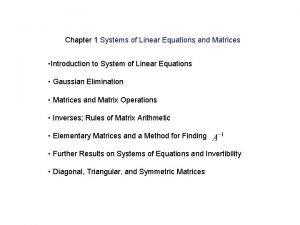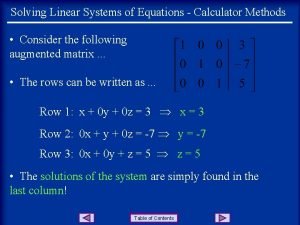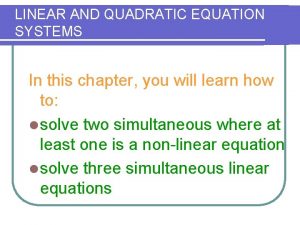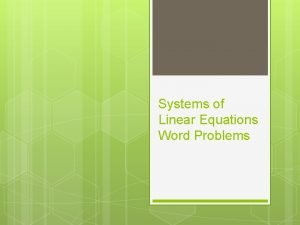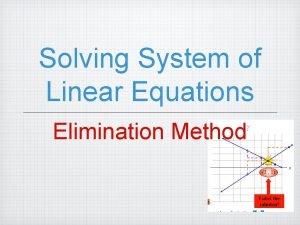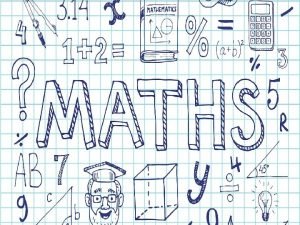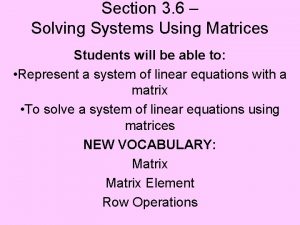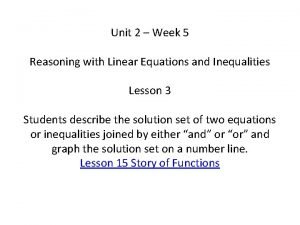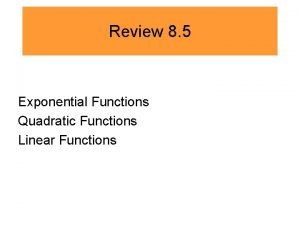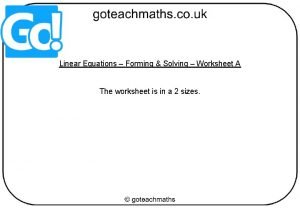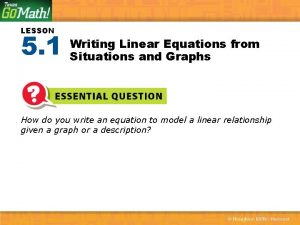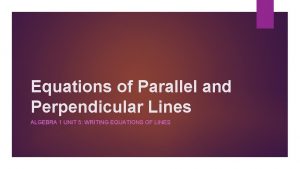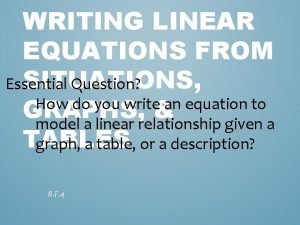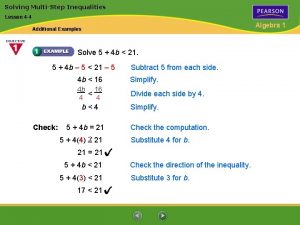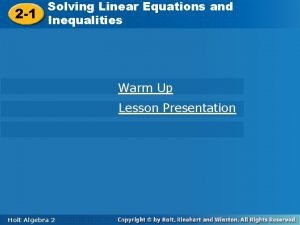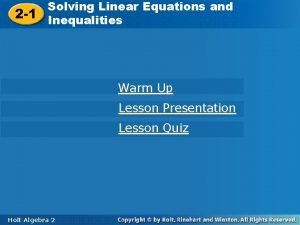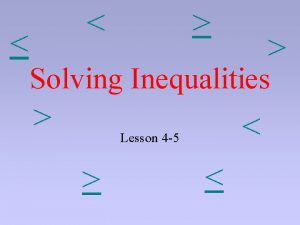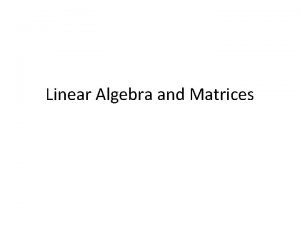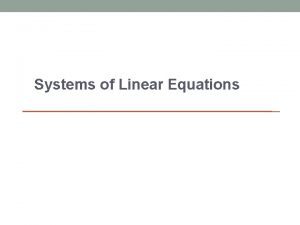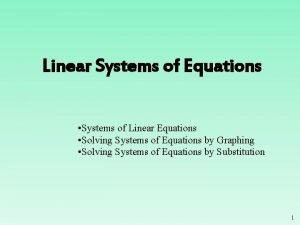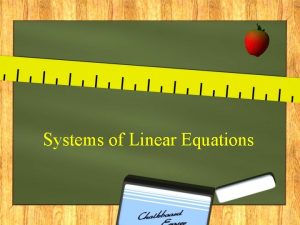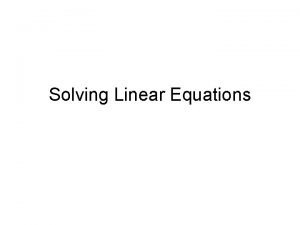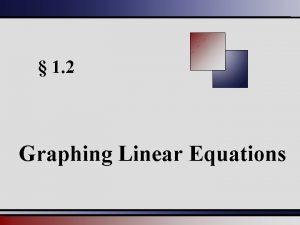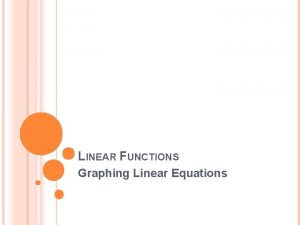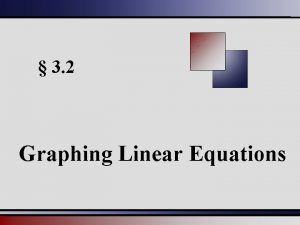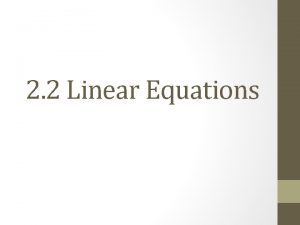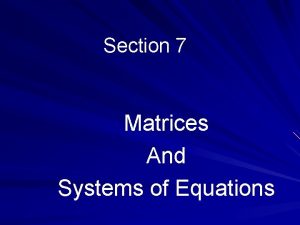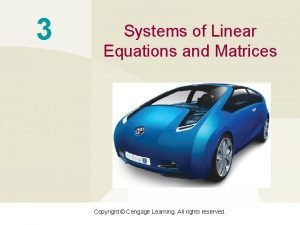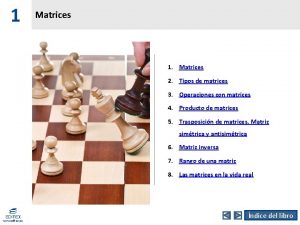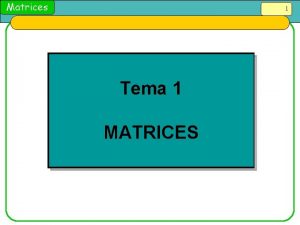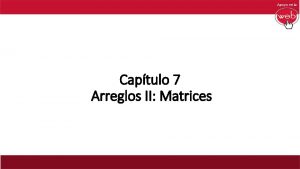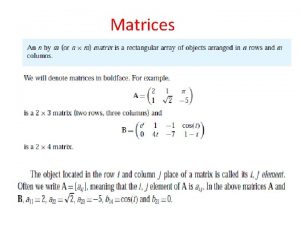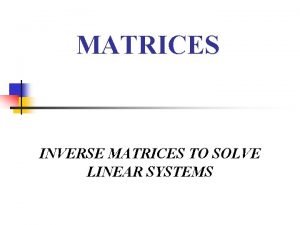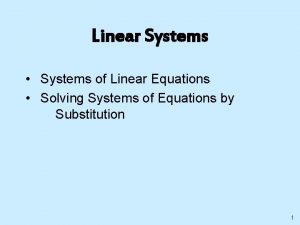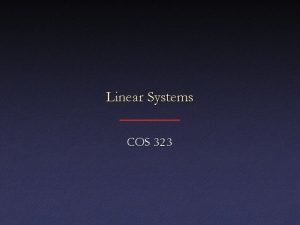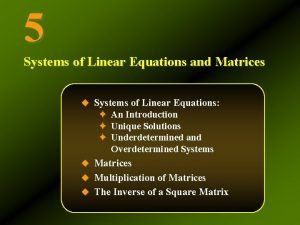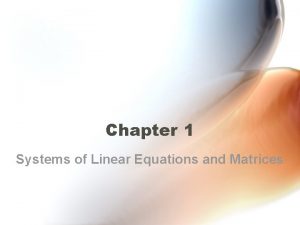3 Systems of Linear Equations and Matrices Copyright
























- Slides: 24

3 Systems of Linear Equations and Matrices Copyright © Cengage Learning. All rights reserved.

3. 1 Systems of Two Equations in Two Unknowns Copyright © Cengage Learning. All rights reserved.

Systems of Two Equations in Two Unknowns Suppose you have $3 in your pocket to spend on snacks and a drink. If x represents the amount you’ll spend on snacks and y represents the amount you’ll spend on a drink, you can say that x + y = 3. On the other hand, if for some reason you want to spend $1 more on snacks than on your drink, you can also say that x – y = 1. These are simple examples of linear equations in two unknowns. 3

Systems of Two Equations in Two Unknowns Linear Equations in Two Unknowns A linear equation in two unknowns is an equation that can be written in the form ax + by = c with a, b, and c being real numbers. The number a is called the coefficient of x and b is called the coefficient of y. A solution of an equation consists of a pair of numbers: a value for x and a value for y that satisfy the equation. 4

Systems of Two Equations in Two Unknowns Quick Example In the linear equation 3 x – y = 15, the coefficients are a = 3 and b = – 1. The point (x, y) = (5, 0) is a solution, because 3(5) – (0) = 15. In fact, a single linear equation such as 3 x – y = 15 has infinitely many solutions: We could solve for y = 3 x – 15 and then, for every value of x we choose, we can get the corresponding value of y, giving a solution (x, y). These solutions are the points on a straight line, the graph of the equation. 5

Systems of Two Equations in Two Unknowns In this section we are concerned with pairs (x, y) that are solutions of two linear equations at the same time. For example, (2, 1) is a solution of both of the equations x + y = 3 and x – y = 1, because substituting x = 2 and y = 1 into these equations gives 2 + 1 = 3 (true) and 2 – 1 = 1 (also true), respectively. So, in the simple example we began with, you could spend $2 on snacks and $1 on a drink. 6

Systems of Two Equations in Two Unknowns In the Example 1, you will see how to graphically and algebraically solve a system of two linear equations in two unknowns. 7

Example 1 – Two Ways of Solving a System: Graphically and Algebraically Find all solutions (x, y) of the following system of two equations: x+y=3 x – y = 1. Solution: We will see how to find the solution(s) in two ways: graphically and algebraically. Remember that a solution is a pair (x, y) that simultaneously satisfies both equations. 8

Example 1 – Solution cont’d Method 1: Graphical We already know that the solutions of a single linear equation are the points on its graph, which is a straight line. For a point to represent a solution of two linear equations, it must lie simultaneously on both of the corresponding lines. In other words, it must be a point where the two lines cross, or intersect. A look at Figure 1 should convince us that the lines cross only at the point (2, 1), so this is the only possible solution. Figure 1 9

Example 1 – Solution cont’d Method 2: Algebraic In the algebraic approach, we try to combine the equations in such a way as to eliminate one variable. In this case, notice that if we add the left-hand sides of the equations, the terms with y are eliminated. So, we add the first equation to the second (that is, add the left-hand sides and add the right hand sides): 10

Example 1 – Solution cont’d 2 x = 4 x = 2. Now that we know that x has to be 2, we can substitute back into either equation to find y. Choosing the first equation (it doesn’t matter which we choose), we have 2+y=3 y=3− 2 = 1. We have found that the only possible solution is x = 2 and y = 1, or (x, y) = (2, 1). 11

Systems of Two Equations in Two Unknowns Graphical Method for Solving a System of Two Equations in Two Unknowns Graph both equations on the same graph. (For example, solve each for y to find the slope and y-intercept. ) A point of intersection gives the solution to the system. To find the point, you may need to adjust the range of x-values you use. To find the point accurately you may need to use a smaller range (or zoom in if using technology). 12

Systems of Two Equations in Two Unknowns Algebraic Method for Solving a System of Two Equations in Two Unknowns Multiply each equation by a nonzero number so that the coefficients of x are the same in absolute value but opposite in sign. Add the two equations to eliminate x; this gives an equation in y that we can solve to find its value. Substitute this value of y into one of the original equations to find the value of x. (Note that we could eliminate y first instead of x if it’s more convenient. ) 13

Systems of Two Equations in Two Unknowns We summarize three possible outcomes we have encountered. Possible Outcomes for a System of Two Linear Equations in Two Unknowns 1. A single (or unique) solution: This happens when the lines corresponding to the two equations are distinct and not parallel so that they intersect at a single point. 2. No solution: This happens when the two lines are parallel. We say that the system is inconsistent. 14

Systems of Two Equations in Two Unknowns 3. An infinite number of solutions: This occurs when the two equations represent the same straight line, and we say that such a system is redundant, or dependent. In this case, we can represent the solutions by choosing one variable arbitrarily and solving for the other. In cases 1 and 3, we say that the system of equations is consistent because it has at least one solution. 15

Applications 16

Example 5 – Blending Acme Baby Foods mixes two strengths of apple juice. One quart of Beginner’s juice is made from 30 fluid ounces of water and 2 fluid ounces of apple juice concentrate. One quart of Advanced juice is made from 20 fluid ounces of water and 12 fluid ounces of concentrate. Every day Acme has available 30, 000 fluid ounces of water and 3, 600 fluid ounces of concentrate. If the company wants to use all the water and concentrate, how many quarts of each type of juice should it mix? 17

Example 5 – Solution In all applications we follow the same general strategy. 1. Identify and label the unknowns. What are we asked to find? To answer this question, it is common to respond by saying, “The unknowns are Beginner’s juice and Advanced juice. ” Quite frankly, this is a baffling statement. Just what is unknown about juice? We need to be more precise: The unknowns are (1) the number of quarts of Beginner’s juice and (2) the number of quarts of Advanced juice made each day. 18

Example 5 – Solution cont’d So, we label the unknowns as follows: Let x = number of quarts of Beginner’s juice made each day y = number of quarts of Advanced juice made each day. 2. Use the information given to set up equations in the unknowns. This step is trickier, and the strategy varies from problem to problem. Here, the amount of juice the company can make is constrained by the fact that they have limited amounts of water and concentrate. 19

Example 5 – Solution cont’d This example shows a kind of application we will often see, and it is helpful in these problems to use a table to record the amounts of the resources used. We can now set up an equation for each of the items listed in the left column of the table. 20

Example 5 – Solution cont’d Water: We read across the first row. If Acme mixes x quarts of Beginner’s juice, each quart using 30 fluid ounces of water, and y quarts of Advanced juice, each using 20 fluid ounces of water, it will use a total of 30 x + 20 y fluid ounces of water. But we are told that the total has to be 30, 000 fluid ounces. Thus, 30 x + 20 y = 30, 000. This is our first equation. 21

Example 5 – Solution cont’d Concentrate: We read across the second row. If Acme mixes x quarts of Beginner’s juice, each using 2 fluid ounces of concentrate, and y quarts of Advanced juice, each using 12 fluid ounces of concentrate, it will use a total of 2 x + 12 y fluid ounces of concentrate. But we are told that the total has to be 3, 600 fluid ounces. Thus, 2 x + 12 y = 3, 600. Now we have two equations: 30 x + 20 y = 30, 000 2 x + 12 y = 3, 600. 22

Example 5 – Solution cont’d To make the numbers easier to work with, let’s divide (both sides of) the first equation by 10 and the second by 2: 3 x + 2 y = 3, 000 x + 6 y = 1, 800. We can now eliminate x by multiplying the second equation by – 3 and adding: 23

Example 5 – Solution So, cont’d y = 2, 400/16 = 150. Substituting this into the equation x + 6 y = 1, 800 gives x + 900 = 1, 800, and so x = 900. The solution is (x, y) = (900, 150). In other words, the company should mix 900 quarts of Beginner’s juice and 150 quarts of Advanced juice. 24
 Homogeneous system of linear equations matrix
Homogeneous system of linear equations matrix System of equations calculator
System of equations calculator Graphical method simultaneous equations
Graphical method simultaneous equations Difference between linear and nonlinear equations
Difference between linear and nonlinear equations Metode gauss seidel
Metode gauss seidel Solving systems of linear and quadratic equations
Solving systems of linear and quadratic equations System of linear equations word problems
System of linear equations word problems Systems of equations
Systems of equations Systems of linear equations real world applications
Systems of linear equations real world applications Special systems of linear equations
Special systems of linear equations Cramer's rule 2x2
Cramer's rule 2x2 Spot mistake
Spot mistake 3-6 solving systems using matrices
3-6 solving systems using matrices Reasoning with linear equations
Reasoning with linear equations How to know if an equation is linear or quadratic
How to know if an equation is linear or quadratic Forming and solving equations worksheet
Forming and solving equations worksheet A camp charges families a fee of $625
A camp charges families a fee of $625 Writing equations of parallel and perpendicular lines
Writing equations of parallel and perpendicular lines 5-1 writing linear equations from situations and graphs
5-1 writing linear equations from situations and graphs 5-3 solving multi-step inequalities
5-3 solving multi-step inequalities Solving
Solving 2-1 solving linear equations and inequalities
2-1 solving linear equations and inequalities Algebra 2 inequalities
Algebra 2 inequalities 1-5 solving inequalities answers
1-5 solving inequalities answers Table linear or nonlinear
Table linear or nonlinear
